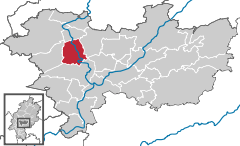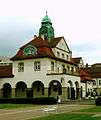Bad Nauheim
| Bad Nauheim | ||
|---|---|---|
 Aerial view | ||
| ||
 Bad Nauheim Location of Bad Nauheim within Wetteraukreis district   | ||
| Coordinates: 50°22′N 8°45′E / 50.367°N 8.750°ECoordinates: 50°22′N 8°45′E / 50.367°N 8.750°E | ||
| Country | Germany | |
| State | Hesse | |
| Admin. region | Darmstadt | |
| District | Wetteraukreis | |
| Government | ||
| • Mayor | Klaus Kreß (Ind.) | |
| Area | ||
| • Total | 32.55 km2 (12.57 sq mi) | |
| Elevation | 148 m (486 ft) | |
| Population (2017-12-31)[1] | ||
| • Total | 32,102 | |
| • Density | 990/km2 (2,600/sq mi) | |
| Time zone | CET/CEST (UTC+1/+2) | |
| Postal codes | 61231 | |
| Dialling codes | 06032 | |
| Vehicle registration | FB | |
| Website | www.bad-nauheim.de | |
Bad Nauheim is a town in the Wetteraukreis district of Hesse state of Germany.
Generalities
As of 2012, Bad Nauheim has a population of 30,788. The town is approximately 35 kilometres (22 mi) north of Frankfurt am Main, on the east edge of the Taunus mountain range. It is a world-famous resort, noted for its salt springs, which are used to treat heart and nerve diseases. A Nauheim or "effervescent" bath, named after Bad Nauheim,[2] is a type of spa bath through which carbon dioxide is bubbled.[2][3] This bath was one of several types of hydrotherapy used at Battle Creek Sanitarium[4] and it was also used at Maurice bathhouse, in Bathhouse Row in the early 1900s, during the heyday of hydrotherapy.[5] The Konitzky Foundation, a charitable foundation and hospital for those without means, was founded in 1896 and its building occupies a central place next to the Kurpark.
History
On September 29, 1945 General Dwight D. Eisenhower reassigned General Patton from his beloved 3rd Army, the army he successfully led from the Normandy landings, to Czechoslovakia as Eisenhower could no longer keep General Patton in position as the Military Governor of Bavaria. General Patton was assigned to command the Fifteenth Army, actually a group of historians given status as an Army, with its headquarters in Bad Nauheim. On December 9, 1945, General Patton left Bad Nauheim for a hunting trip near Mannheim; he died after a car crash during the trip.
The Grand Hotel in Bad Nauheim was also the location of the Gestapo-led internment of around 115 Americans who were working in the U.S. Embassy in Berlin, December 1941. The group would leave Bad Nauheim on May 12, 1942.[6]
In addition, during World War II Adolf Hitler had a command complex in nearby Langenhain-Ziegenberg called Adlerhorst, "the Eagle's Nest" (not to be confused with Kehlsteinhaus of Obersalzberg, which was never referred to as "the Eagle's Nest" by the Nazis).
Bad Nauheim was used as a residential area for American occupation forces after World War II. Despite its proximity to Frankfurt am Main and Hitler's command complex, Bad Nauheim was totally spared from Allied bombing. American occupants from that time were told that President Roosevelt had loved the town so much from his days there that he ordered it spared.
The novel The Good Soldier by Ford Madox Ford (published 1915) is set in part at Bad Nauheim.
Mayors
- 1945–1948: Adolf Bräutigam (SPD)
- 1948–1954: Krafft-Helmut Voss (independent)[7]
- 1954–1960: Fritz Geißler (FDP)
- 1960–1981: Herbert Schäfer (SPD)
- 1981–1993: Bernd Rohde (CDU)
- 1993–1999: Peter Keller (SPD)
- 2000–2005: Bernd Rohde (CDU)
- 2005–2011: Bernd Witzel (UWG)
- since September 2011: Armin Häuser (CDU)
Elvis Presley and others

In the old town center of Friedberg, town next to Bad Nauheim, is the barn at the gate to the castle. The gate, the 'Burgpforte', was used by Elvis Presley as the motif of a record cover for his 1959 #1 hit record 'A Big Hunk o' Love'. Presley lived in Bad Nauheim itself during his time with the United States Army in Friedberg. There is an annual Elvis festival in the city, starting in 2002.[8]
Other famous people who have stayed in the town include Jamshetji Nusserwanji Tata – founder of Tata Group of Companies (he died in Bad Nauheim on 19 May 1904 aged 65), the Irish novelist and man of letters Patrick Augustine Sheehan holidayed at the Hotel Augusta Victoria in Bad Nauheim 6–23 September 1904,[9] Franklin Delano Roosevelt (as a boy, FDR had been taken for several extended visits to Bad Nauheim where his father underwent the water cure for his heart condition), the Saudi Arabian football team during the 2006 FIFA World Cup, General George S. Patton, who celebrated his sixtieth birthday in the grand ballroom of the Grand Hotel and Albert Kesselring, Nazi General who died there in 1960.
Sons and daughters of the town
- Holger Geschwindner (born 1945), basketball player
- Rainer Philipp (born 1950), hockey player
- Klaus Hentschel (born 1961), physicist and historian of science
- Caroline Link (born 1964), Director and Oscar - winner ( Nowhere in Africa )
- Andreas Maier (1967), writer
- Sina-Valeska Jung (born 1979), actress
- Julian Dudda (born 1993), professional football player
The Holocaust
Before the Holocaust there was an on-and-off Jewish presence in Bad Nauheim since around 1303. Before the Holocaust nearly 400 Jews lived in the town, making up nearly 3% of the population. On Kristallnacht the schoolhouse was desecrated and ransacked as well as Jewish stores, businesses and the synagogue. Many Jews were taken that night to concentration camps. Some were let out. Of those let out many were rearrested. By the end of the Holocaust there were just three Jews remaining in Bad Nauheim. For the most part those who were not murdered had left the country.[10]
The Sprudelhof
This complex is recognized as the largest center of Art Nouveau (Jugendstil in German) in Germany.
 A wing of the Sprudelhof
A wing of the Sprudelhof The Art nouveau Spa house
The Art nouveau Spa house The Sprudelhof courtyard
The Sprudelhof courtyard The Sprudelhof
The Sprudelhof Fountain in the Sprudelhof
Fountain in the Sprudelhof- Fountain Modern style sculptures
 Typical "Jugenstil" decoration
Typical "Jugenstil" decoration
Education
- Freie Waldorfschule Wetterau
- Ernst-Ludwig-Schule (Gymnasium)
- St. Lioba Gymnasium (Gymnasium)
- Stadtschule an der Wilhelmskirche (Grund- und Hauptschule)
- Stadtschule Am Solgraben (Haupt- und Realschule)
International relations
Bad Nauheim is twinned with:
References
- ↑ "Bevölkerung der hessischen Gemeinden". Hessisches Statistisches Landesamt (in German). September 2018.
- 1 2 Glanze, W.D.; Anderson, K.N.; Anderson, L.E, eds. (1990). Mosby's Medical, Nursing, and Allied Health Dictionary (3rd ed.). St. Louis, Missouri: The C.V. Mosby Co. ISBN 0-8016-3227-7. p.797
- ↑ Kellogg, J.H., M.D., Superintendent (1908). The Battle Creek Sanitarium System. History, Organisation, Methods. Michigan: Battle Creek. pp. 79, 81, 83, 170, 175, 187. Retrieved 2009-10-30. Full text at Internet Archive (archive.org)
- ↑ Kellogg, J.H. (1908) pp.79,81,83,170,175,187
- ↑ Bathhouse Row Adaptive Use Program / The Maurice Bathhouse: Technical Report 4. National Park Service. June 1985.
- ↑ "The American Internee Experience in Nazi Germany". Retrieved 31 August 2012.
- ↑ Krafft-Helmut Voss, in: Johannes Hürter (Red.):Biographisches Handbuch des deutschen Auswärtigen Dienstes 1871–1945. 5. T–Z, Nachträge. Herausgegeben vom Auswärtigen Amt, Historischer Dienst. Band 5: Bernd Isphording, Gerhard Keiper, Martin Kröger: Schöningh, Paderborn u. a. 2014, ISBN 978-3-506-71844-0, S. 146
- ↑ "Elvis Festival celebrates 14th year in Bad Nauheim, Germany". Retrieved 20 September 2015.
- ↑ His arrival was gazetted in the Koelnische Volkszeitung 6 September 1904
- ↑ "Bad Nauheim". Encyclopaedia of Jewish Communities. Retrieved April 3, 2014.
External links
| Wikimedia Commons has media related to Bad Nauheim. |
- Official website

- Bad Nauheim at Curlie (based on DMOZ)
